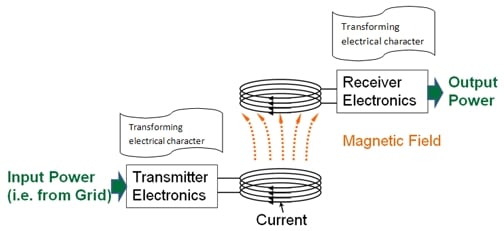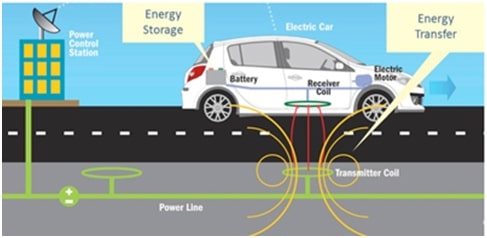New article kindly sent by one of our loyal members of the community: Yasser.
Send us a mail if you want to publish in the blog too!

Figure 1 Basic elements of Wireless Power Transfer
Introduction
In electrical distribution practices, cables form a considerable part of the project at different aspects such as installation time and cost. It’s common to find cables prices exceeds more than 50% of the project budget.
Nicola Tesla dreamed of finding a more efficient way than cables to transfer electricity. In 1891 in the Colorado Springs Lab Nicola Tesla managed to light some bulbs wirelessly placed 18 meter from the power source and this was the first time to successfully transfer electricity wirelessly.
In this article we are discussing wireless power transfer principle, problems against its prevalence and its common applications.
Wireless Power Transfer Principles
The working principle of WPT is similar to the power transformer, but with some differences such as transformer have two coils placed very close to each other and usually each coil is wound on a ferrite material to increase the magnetic coupling but in case of WPT the core is the open air.
The basic elements to achieve WPT are two, transmitter and receiver.
The first one is to have a transmitter which requires circuits to convert the 50 Hz to the optimal WPT frequency to improve efficiency and reduce effects on human body, this frequency is below 10 MHz. This transmitter is connected to a coil which generates a changing magnetic field.
The second element is receiver, another coil to capture the magnetic field and EMF is generated between its terminals, also some circuits are required to change the frequency of the received power. The following figure shows the basic elements:

Figure 1 Basic elements of Wireless Power Transfer
Basic Technologies
Inductive Coupling
This technology is used for small distance WPT and based on two coils only. Used for mobile charging and electric cars charging which will be so effective in electric car industry as cars won’t need to stop for charging.

Figure 2 Wireless charging for electric cars
Resonant Inductive Coupling
Used for small distance Wireless Power Transfer . By using a resonance circuit includes capacitor and inductor, WPT can be more efficient with better magnetic coupling. Nicola Tesla used this method at his first experiment.

Figure 3 Wireless Power Transfer using Resonance on secondary side
Microwave Power Transmission (MPT)
The Ac is converted to Dc, then Dc is converted to Microwave at high frequency usually in Giga Hz and transmitted into space. The receiving device is called Rectenna which receives and converts Microwaves to Dc again.
Laser Power Transmission
Laser can be highly directed thus low power loss, but it gets attenuated through atmosphere, here the receiver is, so simple as it can be a solar cell.
Limitations on Wireless Power Transfer
- Magnetic field strength is inversely proportional with the cube of distance between transmitter and receiver so the power efficiency is so low for long distance.
- Safety of personnel is a strong limitation as being exposed to magnetic field all time will lead to many harms for your body. And in case of exposure to a high power magnetic field range, you may get fired.
- Unless the magnetic field is precisely directed to each receiver, then each load would need overcurrent protection as current limiter. As the undirected field will induce currents in each device in its range.
- Magnetic field will energize any metal in its range thus this provides hazards for human.
- A main problem for power station is that in case of WPT, load control will be so hard as the station would act as a transmitter, thus any receiver will be able to receive power and in turns load shedding and protection is not that easy.
Conclusion
Many researches are done in this field and to find a safe, reliable and efficient way to transfer power wirelessly, but all results were on small range of power and distance. Till now we can’t imagine how WPT will be in future and if Nicola tesla’s dream will be real or not, a vague future for such impressive transmission method. We will wait and see how science will impress us.